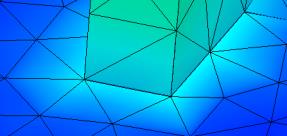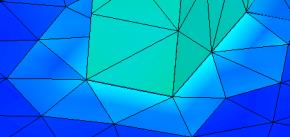Defining and Viewing Advanced Results—Creo Ansys Simulation
In addition to the basic result quantities that are available for every simulation study that runs, you can also define and save the following advanced results for simulation studies:
Advanced results are created for specific references in your model.
Contour Plots
You can use a contour plot to visualize and assess gradients for result quantities displayed on a surface or volume. Different color bands represent different values of the result quantity.
To create a contour plot for a result quantity, perform the following steps:
1. Click > to open the Contour Plot dialog box.
2. Select references at which you want to study a result. Valid references are models, bodies, surfaces, edges or datum planes. You can select mixed references but you cannot select any other reference along with a datum plane. Use the Selection Filter at the bottom right of the window to filter a particular geometry. This makes it easier to select multiple references for larger and more complex models.
For non-geometry references such as contacts, idealizations, or joints, all the available references are automatically available in the References collector. Select the reference at which you want to create a result.
3. Select a result from the Results type list, which shows the commonly used results. Click Other if you want to select other advanced results.
4. Optionally, clear or select the Use nodal averaging check box.
 |
 |
|
Select the Use nodal averaging check box to display continuous contours across element boundaries, as the value of the result is averaged at each node. Adjacent elements show a smooth color transition.
|
Clear the Use nodal averaging check box to display gradients across adjacent elements. The contours are discontinuous across element boundaries. Adjacent elements show a sharper difference in colors.
|
This check box is only available for stresses, strains, and contact results for structural studies, and heat flux and temperature gradients in the case of thermal studies.
5. Click OK to create the advanced result. The result is displayed in the Simulation Tree.
Vector Plots
You can use vector plots to display result quantities such as displacement, force reaction, or heat flux that display both direction and magnitude. Vector plots are used to display the directional behavior of a quantity by superimposing sets of colored arrows over a transparent view of your model. The range of a quantity is represented by a specific color. The length and color of the arrow denote the magnitude of the directional forces. The vectors help you visualize the direction of changing quantities.
To create a vector plot result perform the following steps:
1. Click > to open the Vector Plot dialog box.
2. Select references at which you want to study a result. Valid references are models, bodies, surfaces, edges or datum planes. You can select mixed references but you cannot select any other reference along with a datum plane. Use the Selection Filter at the bottom right of the window to filter a particular geometry. This makes it easier to select multiple references for larger and more complex models.
For non-geometry references such as contacts, idealizations, or joints, all the available references are automatically available in the References collector. Select the reference at which you want to create a result.
3. Select a result from the Results type list.
4. Click OK to create the result.
Advanced Results Mini Toolbar
Advanced results are displayed along with a mini toolbar that contains the following commands:
•  —Indicates that the results are advanced results. Also used as a handle to drag and reposition the mini toolbar anywhere in the Graphics Window.
—Indicates that the results are advanced results. Also used as a handle to drag and reposition the mini toolbar anywhere in the Graphics Window.
 —Indicates that the results are advanced results. Also used as a handle to drag and reposition the mini toolbar anywhere in the Graphics Window.
—Indicates that the results are advanced results. Also used as a handle to drag and reposition the mini toolbar anywhere in the Graphics Window.•  —Starts animation of deformation results.
—Starts animation of deformation results.
 —Starts animation of deformation results.
—Starts animation of deformation results.•  —Pauses the animation of deformation results.
—Pauses the animation of deformation results.
 —Pauses the animation of deformation results.
—Pauses the animation of deformation results.•  —Stops the animation of deformation results.
—Stops the animation of deformation results.
 —Stops the animation of deformation results.
—Stops the animation of deformation results.•  —Changes the speed of animation.
—Changes the speed of animation.
 —Changes the speed of animation.
—Changes the speed of animation.•  —Stops displaying the results and returns to the Creo Ansys Simulation application.
—Stops displaying the results and returns to the Creo Ansys Simulation application.
 —Stops displaying the results and returns to the Creo Ansys Simulation application.
—Stops displaying the results and returns to the Creo Ansys Simulation application.Updating Results
If you add an advanced result to a study after the simulation study run has completed the results show a status of not evaluated ( ) in the Simulation Tree. Right-click Results in the Simulation Tree and click
) in the Simulation Tree. Right-click Results in the Simulation Tree and click  Update Results to evaluate the newly added advanced results. Similarly, simulation probes that are created after a study run completes are also not evaluated until you click
Update Results to evaluate the newly added advanced results. Similarly, simulation probes that are created after a study run completes are also not evaluated until you click  Update Results.
Update Results.
 ) in the Simulation Tree. Right-click Results in the Simulation Tree and click
) in the Simulation Tree. Right-click Results in the Simulation Tree and click  Update Results to evaluate the newly added advanced results. Similarly, simulation probes that are created after a study run completes are also not evaluated until you click
Update Results to evaluate the newly added advanced results. Similarly, simulation probes that are created after a study run completes are also not evaluated until you click  Update Results.
Update Results.When you run the  Update Results command all results and probes for the active study are evaluated and updated. Update Results command all results and probes for the active study are evaluated and updated. |